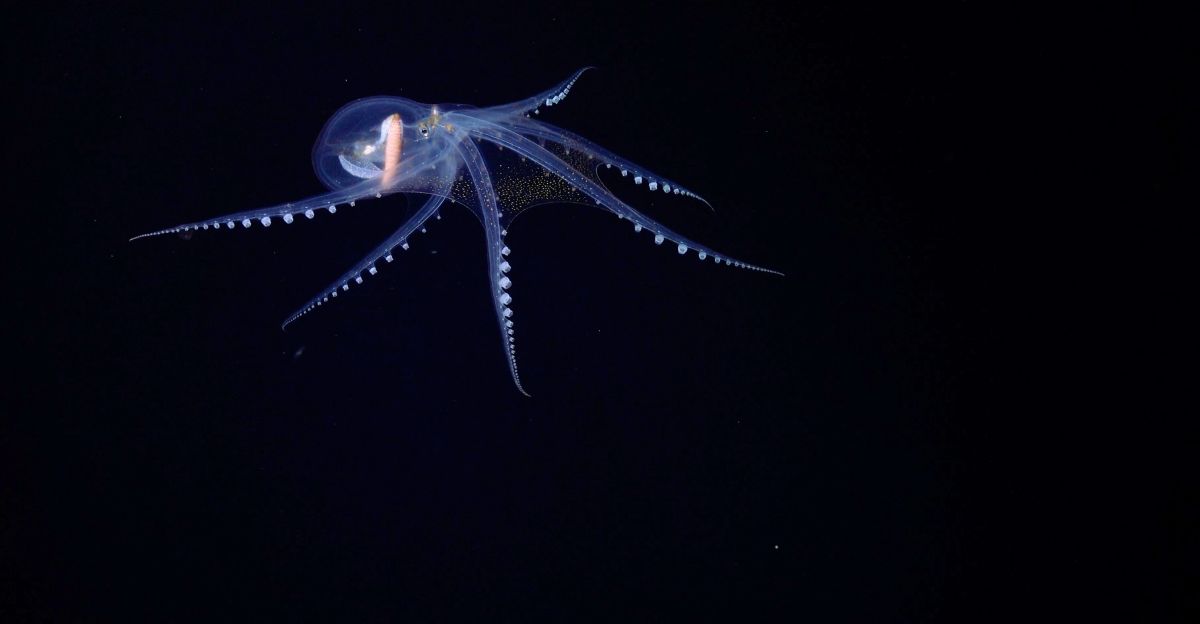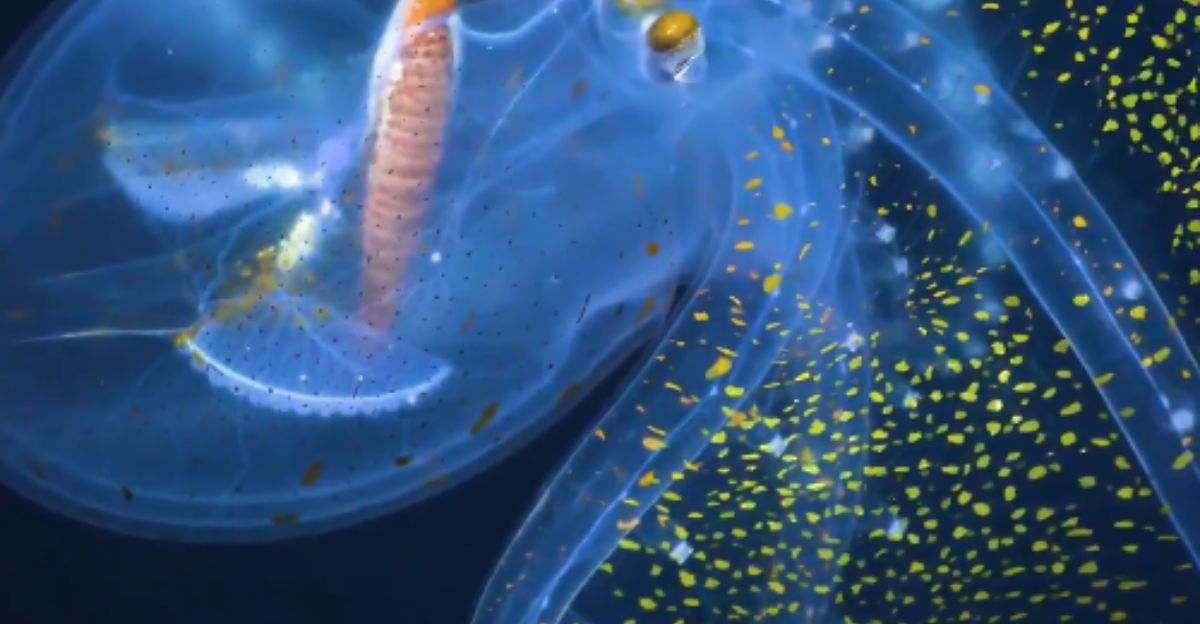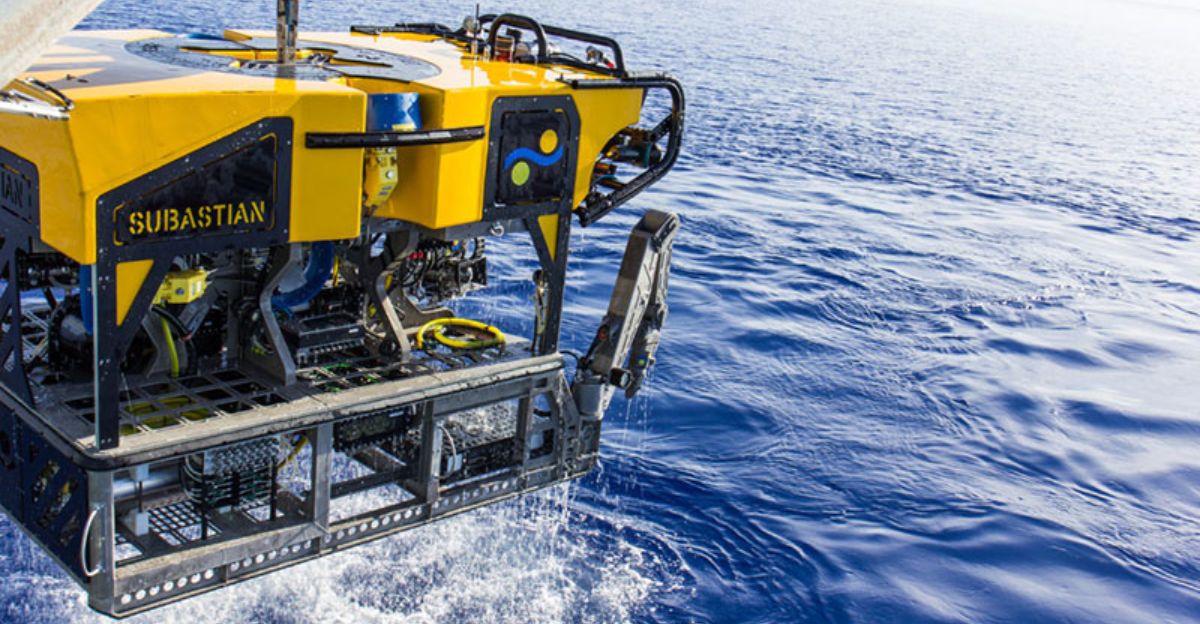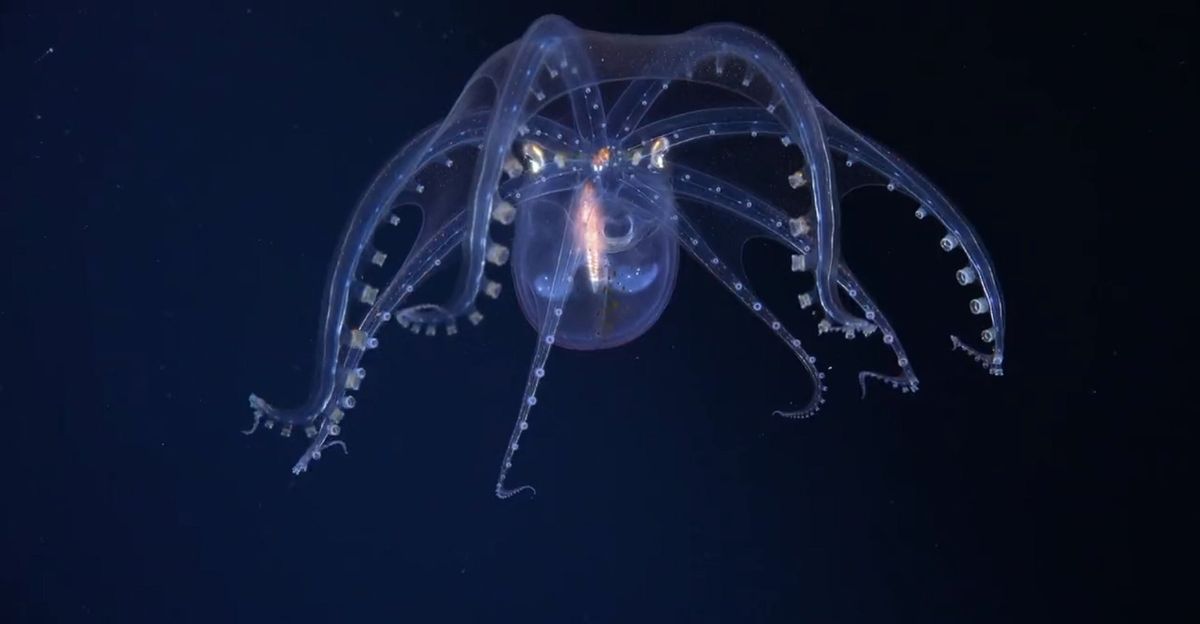
The glass octopus, or Vitreledonella Richardi, is a deep-sea cephalopod that is well-known for having a nearly transparent body that only shows its eyes, digestive tract, and optic nerve. In the mesopelagic and bathypelagic zones, which are 200–3,000 meters deep, this extreme transparency is an evolutionary adaptation that helps them avoid predators and ambush prey.
Beyond simple documentation, this discovery is significant because it casts doubt on our knowledge of deep-sea biodiversity and marine life’s adaptations to harsh conditions. This accomplishment also emphasizes how crucial it is to keep funding oceanographic research and exploration efforts in order to find the innumerable undiscovered species that call the world’s vast and mostly uncharted oceans home.
Scientific Significance and Historical Context

This finding emphasizes the significance of cutting-edge technology in deep-sea research and shows how much of the ocean’s biodiversity is still unknown. In addition to proving the creature’s existence, the video provides previously unattainable opportunities to research its behavior, physiology, and ecological role.
The technical difficulties of exploring extreme depths, where pressure, darkness, and cold create formidable barriers, have historically made deep-sea creatures like the glass octopus mysterious. This discovery dispels the myth that the deep ocean is a desolate wasteland and instead shows a diverse ecosystem complete with organisms that have adapted to survive in hostile environments.
Evolutionary Survival Strategies

To evade detection, the glass octopus’s transparency, which minimizes its silhouette against the faint ocean light, is a masterful example of evolutionary camouflage. Its bioluminescent organs can flashlight to deceive predators, and its cylindrical eyes reduce its shadow when viewed from below. The extreme predation pressures in deep-sea environments, where survival relies on cunning and stealth, are highlighted by these adaptations.
The octopus’s almost undetectable body is a sophisticated evolutionary solution that has been refined over millions of years, demonstrating the effectiveness of natural selection in harsh environments. Biotechnology may be affected by these adaptations, which also bring up fascinating questions regarding the developmental and genetic processes that allow transparency and bioluminescence.
Innovations in Technology Facilitating Exploration

In order to photograph the glass octopus, technology, specifically the remotely operated vehicle SuBastian, was essential. With SuBastian’s deep-sea exploration capabilities, scientists were able to record and navigate at depths of over 800 meters, which was previously unattainable for live observation. The discovery of the glass octopus and the documentation of other uncommon species and behaviors were made possible by this technological advancement.
Researchers now engage with the deep sea in a tangible ecosystem rather than a mysterious void thanks to the integration of high-definition cameras, precise maneuvering capabilities, and real-time data transmission. This development is a prime example of how biology and engineering can work together to solve new scientific problems by using state-of-the-art instruments.
Role of Ecology

As a predator and prey, the glass octopus is an essential component of deep-sea ecosystems. It aids in controlling the populations of fish, invertebrates, and small crustaceans by feeding on them. It links trophic levels in the ocean’s food web by acting as prey for larger marine creatures like sharks and whales.
Researchers can draw conclusions about the condition of deep-sea environments and the possible ripple effects of environmental changes by knowing the glass octopus’s place in the food chain. This information is essential for creating conservation plans that safeguard both individual species and the intricate webs that support marine life.
Implications and Dangers for Conservation

The glass octopus is threatened by pollution, climate change, and habitat degradation despite its remote habitat. The importance of marine conservation initiatives to safeguard delicate deep-sea ecosystems is highlighted by the documentation of such species. The finding is a wake-up call to protect hotspots for biodiversity and incorporate deep-sea species into international conservation strategies.
Despite being a crucial part of Earth’s biosphere that affects biogeochemical cycles and the global climate, the deep ocean is frequently disregarded in environmental discussions. International collaboration and creative management strategies that tackle regional and global threats are necessary to protect species like the glass octopus.
The Discovery’s Effects on Culture and Science

The glass octopus video’s viral spread has captured the public’s interest and increased awareness of the ocean’s mysteries and deep-sea life. It dispels the myth that the ocean’s depths are empty, exposing a world full of intricate, fantastic life. This finding encourages interest in and support for marine research by bridging the gap between science and society.
Such a cultural impact demonstrates how scientific discoveries have an impact outside of academia by influencing funding priorities and policy. Additionally, it promotes interdisciplinary cooperation by fusing science, art, and education to persuasively and easily convey the significance of ocean exploration and preservation.
Prospective Uses and Future Lines of Investigation

The transparency and bioluminescence of the glass octopus offer fascinating opportunities for biomimicry in domains like materials engineering, nanotechnology, and optics. Researching its physiology may lead to advancements in light manipulation or camouflage materials. Its reproductive habits, population dynamics, and reactions to environmental changes should be the main topics of future study.
Furthermore, knowledge of this species’ adaptations to deep-sea temperatures and pressures may help with industrial and medical applications. In addition to advancing scientific understanding, ongoing research and investigation will stimulate technological advancement, highlighting the immense significance of biodiversity as a wellspring of ideas and workable solutions.
Divergent Views and Scientific Difficulties

Despite the celebration, some scientists advise against romanticizing the discovery too much in the absence of solid ecological evidence. The infrequency of sightings could be due to actual scarcity or just the difficulties of deep-sea observation. Furthermore, studies of larger ecosystems run the risk of being overshadowed by the attention paid to charismatic species like the glass octopus.
With a focus on the necessity of thorough data collection and ecosystem-based management, this cautious approach promotes a measured approach to exploration and conservation. It also draws attention to the ethical issues surrounding deep-sea research, where the need to minimize damage to delicate species and their habitats must be balanced with the quest for knowledge.
Conclusion and Wider Consequences

A significant accomplishment that advances our knowledge of deep-sea biodiversity and evolutionary adaptation is the first-ever video of the glass octopus. It is a prime example of how advanced technology can shed light on the unknown and uncover species that defy our preconceived ideas about visibility and survival.
The wider ramifications reach into global environmental stewardship, where protecting deep-sea ecosystems supports resilience in biodiversity, food security, and climate regulation. Reflection on humanity’s responsibility to preserve the planet’s remaining frontiers and the necessity of promoting sustainable relationships with nature via knowledgeable science and proactive policy are encouraged by this milestone.
Explore more of our trending stories and hit Follow to keep them coming to your feed!

Don’t miss out on more stories like this! Hit the Follow button at the top of this article to stay updated with the latest news. Share your thoughts in the comments—we’d love to hear from you!







